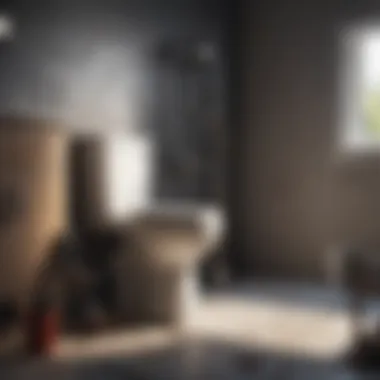Proven Techniques to Unblock Your Toilet Effectively


Intro
Effective DIY Techniques
For minor to moderate clogs, several DIY methods can effectively restore your toilet's functionality. Here are some approaches:
- Plunger Use: This tool is essential for any household. Ensure you have a flange plunger for toilets. First, ensure there is enough water in the bowl to cover the plunger. Position the plunger seal over the drain hole, creating a tight seal, and push down gently. Pull upwards sharply to dislodge the clog. Repeat this until the water drains correctly.
- Hot Water and Liquid Soap: Using hot (but not boiling) water can help break down blockages. Pour a reasonable amount of liquid dish soap into the toilet bowl, followed by hot water. Let this sit for around 10-15 minutes before attempting to flush. The soap will lubricate the drain and help to break up the clog.
- Baking Soda and Vinegar: A natural method involves pouring one cup of baking soda followed by two cups of vinegar into the toilet. Wait for about 30 minutes, then flush. This combination can dissolve organic matter that contributes to clogs.
Advanced Tools for Severe Blockages
In cases of stubborn or severe blockages, additional tools may be necessary. Some of these tools include:
- Toilet Auger: This is a specialized tool designed to reach deeper clogs in the toilet trap. Insert the cable into the toilet drain and rotate the handle to break up the blockage or retrieve foreign objects.
- Wet/Dry Vacuum: For blockages caused by solid waste or non-dissolvable items, a wet/dry vacuum may be useful. Create a tight seal around the toilet bowl. Switch the vacuum to liquid mode and attempt to suck out the clog directly.
Understanding Causes of Blockages
It’s vital to recognize the common contributors to toilet blockages. Some may include:
- Excessive toilet paper use
- Foreign objects accidentally flushed
- Poor plumbing design
These issues can often be mitigated through awareness and thoughtful use of the toilet.
Preventive Measures
To maintain plumbing health and reduce the likelihood of blockages:
- Educate all household members about what can and can’t be flushed.
- Address slow drains promptly, as they can be indicators of larger issues.
- Consider scheduling regular plumbing inspections to ensure everything functions properly.
"Regular maintenance of your plumbing system is key to preventing issues before they become serious problems."
Ending
In summary, understanding how to effectively unblock a toilet involves a combination of techniques and tools, along with an awareness of potential causes. By employing these methods, you can ensure the longevity of your plumbing while also maintaining convenience in your daily life. Effective prevention and education go a long way in avoiding the stress of unexpected blockages.
Understanding Toilet Blockages
Toilet blockages are not just minor nuisances; they represent a more significant issue that can affect plumbing integrity and household hygiene. Understanding toilet blockages allows homeowners and renters to take timely action, ensuring sanitary conditions and preventing further complications. This section delves into the causes, signs, and importance of promptly addressing a blocked toilet, offering practical insights to manage and mitigate the problem effectively.
Common Causes of Toilet Blockages
Toilets may become blocked due to various factors. Recognizing these causes is key in preventing future issues. Common culprits include:
- Excessive toilet paper: Flushing large amounts can overwhelm the plumbing.
- Foreign objects: Items like toys, sanitary products, or wipes may inadvertently end up in the toilet.
- Structural issues: Age and wear in plumbing can lead to collapses.
- Tree roots: Infiltration from tree roots can obstruct pipes, causing severe blockages.
Awareness of these causes helps in taking preventive steps, such as educating family members about toilet use.
Signs That Your Toilet is Blocked
Recognizing the indicators of a blocked toilet promptly can save time and further damage. Keep an eye out for these signs:
- Slow drainage: Water taking longer than usual to drain after flushing can signal a problem.
- Unpleasant odors: Foul smells can arise as waste accumulates in the pipes.
- Gurgling sounds: Unusual noises while flushing may indicate air trapped in the plumbing system.
- Water level changes: A fluctuating water level in the toilet bowl can suggest a blockage.
These signs, if ignored, may lead to more severe plumbing problems down the line.
The Importance of Addressing Blockages Promptly
Addressing blockages without delay is critical. Ignoring them might lead to increased risks, such as:
- Overflowing toilets: A backed-up toilet can flood bathrooms, resulting in significant water damage.
- Health hazards: Stagnant water can promote mold and bacteria growth, posing health risks to residents.
- Higher repair costs: Prolonged blockages may require professional intervention, potentially leading to expensive repairs.


As such, taking immediate action is vital. A proactive approach not only enhances home hygiene but also preserves plumbing systems for the long term.
"Understanding the nature and signs of toilet blockages can empower homeowners. It allows for a proactive stance in plumbing maintenance and prevents minor issues from escalating."
By familiarizing oneself with these elements, managing toilet blockages becomes a less daunting task and can be tackled competently.
Initial Assessment
In the process of unblocking your toilet, the initial assessment is an essential first step. This phase allows for a clearer comprehension of the blockage's nature and lays the groundwork for effective resolution. By accurately diagnosing the situation, you can determine the most suitable tools and methods to apply, saving both time and effort.
Checking the Water Level
The first action in your assessment should involve checking the water level in the toilet bowl. An abnormal water level is often indicative of a blockage. If the water is too high, it signifies that waste is unable to flow as it should. Conversely, a low water level may suggest a partial blockage or an issue further down the drain.
To execute this check:
- Observe the flow when flushing. Does it take longer than usual for the bowl to refill?
- Take note of any gurgling noises from the toilet or nearby drains, which can signify trapped air due to a malfunctioning drain.
Being aware of these factors helps in dismantling the problem before attempting any physical unblocking methods.
Identifying the Location of the Blockage
Following your water level assessment, the next crucial step is identifying the location of the blockage. This insight is pivotal for selecting the appropriate tools or techniques. Blockages can occur at various points: within the toilet, in the immediate plumbing, or further down the sewage line.
Methods for identifying the blockage location include:
- Visual Inspection: Check the toilet bowl and the tank for any visible signs of backflow or waste accumulation.
- Listening for Sounds: Gurgling sounds in the toilet or sinks may indicate a buildup obstructing the drainage path.
- Using Diagnostic Tools: If needed, a simple plumbing snake can help gauge the depth of a blockage.
"Engaging in a methodical approach by assessing both water level and blockage location can save you from unnecessary mess and effort later on."
Understanding where the blockage lies is crucial, as this informs your decision on whether to utilize simple tools like a plunger or more advanced equipment such as an auger. Allocating time to this assessment phase can mitigate further complications down the line.
Basic Tools for Unblocking
Understanding the basic tools used for unblocking toilets is essential for homeowners and renters facing frequent plumbing issues. Equipped with adequate knowledge, individuals can tackle clogs efficiently without relying exclusively on professional services. The prominence of these tools lies in their straightforward usage and effectiveness, making them accessible for most people.
Plunger: A Traditional Weapon
The plunger is perhaps the most recognizable tool for unblocking toilets. Its simple design and ease of use have made it a staple in many households. This tool essentially creates pressure that can dislodge blockages within the toilet trap or between the toilet and the drain.
Types of plungers
There are mainly two types of plungers: the cup plunger and the flange plunger. The cup plunger has a rounded rubber cup that fits snugly into the toilet bowl. This type is beneficial for standard toilets and is widely used due to its effectiveness. The flange plunger, on the other hand, includes an extended rubber flap that provides a better seal. This unique feature improves suction and is particularly useful for tougher clogs.
- Cup Plunger: Best for general use in household toilets.
- Flange Plunger: Ideal for toilets due to its design, allowing for deeper reach into toilet traps.
Each type has its benefits and disadvantages. Cup plungers can be less efficient for toilets specifically, whereas flange plungers may not work as well for sinks or showers.
How to use a plunger effectively
Using a plunger may seem straightforward, but employing the correct technique is vital. To use a plunger effectively, one must first ensure a tight seal around the toilet drain. Begin by positioning the plunger directly over the drain and pressing down gently to remove any air. Then, push and pull with force, maintaining a consistent rhythm. It's important not to lift the plunger too high, as this can break the seal and reduce effectiveness.
This approach not only helps remove blockages but also promotes a clean flow through the pipes. Common mistakes include using inadequate force or not waiting long enough before assuming the blockage is clear.
Augers: For Stubborn Clogs
In instances where plungers do not yield results, an auger may be required. An auger, also known as a plumbing snake, is a tool designed to reach deeper blockages that a plunger cannot dislodge. This tool can navigate bends in the piping, making it ideal for more complex clogs.
Different types of augers


There are several types of augers suitable for different situations. A closet auger is specifically designed for toilets. It features a reinforced cable that can withstand the pressure of blockages. A drain auger, however, is better for sinks and drains, having a longer reach.
The auger's ability to penetrate deeper blockages makes it a valuable tool. Unlike plungers, augers can handle foreign objects that may have been accidentally flushed.
Proper usage techniques
Using an auger requires a specific method to be effective. First, insert the auger into the toilet until it encounters resistance, indicating a blockage. Then, turn the handle slowly as you push downwards to work the auger through the clog. If you need to pull the auger back, do so gently to avoid damaging the toilet. This technique helps to capture and break apart the obstruction effectively.
Using an auger does have its challenges. It can be physically demanding, and improper use may result in mess or damage to the toilet, so caution is necessary.
Proper knowledge of basic tools like plungers and augers empowers individuals to manage blockages effectively, saving time and expense.
Chemical Solutions
Chemical solutions play a crucial role in addressing toilet blockages. They often provide a quick and effective way to dissolve various obstructions without the need for mechanical tools. Understanding how these products work can enhance your ability to handle plumbing issues effectively.
Chemicals can break down waste material, paper, and even certain types of clogs caused by buildup over time. However, relying solely on these substances can pose risks if not used properly. Careful consideration of the type of drain cleaner and its appropriate application is vital in ensuring both effectiveness and safety.
Types of Drain Cleaners
Several types of drain cleaners are available in the market, each formulated for specific clog types. Here are some of the more common options you might encounter:
- Liquid Drain Cleaners: These are typically caustic substances that work by producing heat to dissolve clogs. They are often effective against organic matter.
- Gel Drain Cleaners: These are denser and stick to the sides of pipes, allowing them to attack stubborn blockages more efficiently than liquid forms.
- Enzyme-Based Cleaners: These are less harsh and use natural enzymes to break down waste materials. They are often preferred for regular maintenance as they are environmentally friendly.
- Foaming Drain Uncloggers: These release a foam that expands to reach all areas within a pipe, providing thorough treatment of clogs located in hard-to-reach spots.
Choose a cleaner that specifically suits the kind of blockage you’re facing. Using the wrong type can result in less effective results or even damage to your plumbing.
Safety Considerations When Using Chemicals
While chemical cleaners can be effective, there are certain safety precautions that users must take into account:
- Read Instructions: Always start by carefully reading the label and instructions on the product. This will provide essential information on application and potential hazards.
- Protective Gear: Wear necessary protective gear such as gloves and goggles to prevent any splashes from harming your skin or eyes.
- Ventilation: Ensure that the area is well-ventilated. Fumes can be toxic and should not be inhaled.
- Do Not Mix Chemicals: Mixing different types of drain cleaners can produce dangerous reactions. Always use one product at a time and follow the indicated waits between applications if necessary.
- Store Safely: Keep chemicals out of the reach of children and pets to prevent accidental ingestion or exposure.
Using drain cleaners can simplify the unblocking process, yet proper knowledge and safety measures should prevail to prevent hazardous situations.
By remaining informed about chemical solutions and their proper use, you can effectively manage toilet blockages while safeguarding your home environment.
Eco-Friendly Alternatives
In the quest to maintain a household, the choice of methods for unblocking toilets can reflect broader values. Using eco-friendly alternatives not only addresses immediate plumbing issues but also promotes sustainable living practices. The importance of this topic cannot be overstated. Most conventional drain cleaners contain harsh chemicals that can damage pipes, harm the environment, and pose health risks. In contrast, eco-friendly methods typically rely on common household items that are safe, effective, and much kinder to the planet.
The benefits of using these methods are multifaceted. First, they are generally cheaper than commercial products, which can be a significant factor for many. Second, these solutions are often just as effective, if not more so, than their chemical counterparts, given the right application. Additionally, by opting for natural ingredients, homeowners can avoid contributing to water pollution, which is a pressing environmental issue. These measures also extend the longevity of plumbing systems, ultimately saving time and money in the long run.
When considering eco-friendly alternatives, it is essential to understand how individual solutions work. Here are two effective methods worth exploring:
Baking Soda and Vinegar Method
The baking soda and vinegar approach is one that many find effective due to its simplicity and availability. To begin, pour about one cup of baking soda directly into the toilet bowl. Following this, add one to two cups of white vinegar. The chemical reaction between these two substances will create foam as they interact. Allow this mixture to sit for about 30 minutes. This time frame is crucial as it lets the combination break down clogs effectively.
After the allotted time, it is beneficial to flush the toilet with hot water. This hot water can help to push the loosened debris through the drain system. By engaging with this eco-friendly method, individuals contribute to a more sustainable way of managing household plumbing issues.
Hot Water and Dish Soap Solution
Another method worth considering is the combination of hot water and dish soap. Begin by pouring a generous amount of dish soap into the toilet bowl. This soap acts as a lubricant, making it easier for clogs to break apart. Following this, heat water in a kettle or pot. It is crucial that the water is hot, not boiling, to avoid damaging the porcelain.
Once the water reaches the desired temperature, carefully pour it into the toilet bowl from waist height. This height helps to increase the force of the water, further assisting in unclogging the toilet. Allow the mixture to sit for about 15 to 20 minutes and then attempt to flush. If successful, this approach illustrates how simple household items can be utilized for plumbing solutions without the need for harmful chemicals.
Key Takeaway: Eco-friendly alternatives offer practical, effective solutions for unblocking toilets while promoting a healthier environment.
Advanced Techniques


Advanced techniques for unblocking a toilet are vital to understanding the broader scope of plumbing maintenance. They go beyond basic methods, addressing more stubborn blockages that may not yield to conventional tools. Homeowners often encounter situations where typical solutions fail, making these advanced strategies essential for proper toilet care. These techniques can save time and prevent potential damage to plumbing systems.
The main aspects of these methods include efficiency, safety, and long-term effectiveness. By being aware of when to employ advanced techniques and the tools they require, you can manage toilet blockages with greater success.
Using a Wet/Dry Vacuum
A wet/dry vacuum can be a powerful ally when dealing with severe toilet blockages. This tool excels at removing water and debris effectively from both liquid and solid clogged matter. It is essential to ensure that the vacuum is rated to handle liquids; not all vacuums can manage this task.
To use a wet/dry vacuum properly, follow these steps:
- Preparation: Before starting, collect necessary items. Have gloves, a bucket, and towels ready. This will help keep the area clean.
- Set the Vacuum: Adjust the vacuum for wet use by switching the setting and attaching the proper hose. If your vacuum has a filter designed for wet cleaning, ensure it is in place.
- Suction: Carefully insert the hose into the toilet bowl, ensuring it creates a decent seal. Turn on the vacuum and allow it to suck up the water and debris.
- Monitor Progress: Periodically check the collection tank of the vacuum. Empty it regularly to prevent overflow.
- Cleanup: After successfully clearing the blockage, clean the vacuum’s components according to the manufacturer's instructions.
Using a wet/dry vacuum not only clears the blockage but also eliminates excess water, which can be crucial in preventing further issues down the line.
When to Call a Professional Plumber
There are occasions when a blockage is too severe for home remedies, and calling a professional plumber becomes necessary. You should consider this option if:
- Persistent Clogs: If a clog recurs frequently despite your efforts, it could indicate a deeper issue in your plumbing system.
- Sewage Backup: If you notice sewage odors or a backup in other fixtures, this may require expert attention to prevent further damage.
- Failure of Methods: If all available methods, including advanced techniques, fail to unblock the toilet, the problem may lie beyond your home's immediate plumbing.
- Safety Concerns: If chemicals were used and you feel uncertain about safely handling potential toxic reactions, it is wise to seek professional help.
Trying to manage a situation beyond your expertise can lead to more significant problems. Plumbers have specialized tools and experience that can save you from costly repairs and extended inconveniences. In cases where the situation grows complex, it is best to prioritize safety and professional input.
Remember: When in doubt, hiring a professional is often the most efficient and cost-effective solution.
Preventive Measures for Future Blockages
Preventive measures for toilet blockages are crucial for maintaining a smoothly operating plumbing system. Engaging in these practices can significantly reduce the chances of encountering clogs, enhancing both convenience and hygiene within the home. Moreover, understanding the factors that contribute to blockages can empower homeowners and renters to take proactive steps in safeguarding their toilets against unwanted issues. By being mindful of what goes into the toilet and following a few straightforward maintenance tips, users can enjoy a more reliable toilet experience.
Understanding What Can Be Flushed
Flushing the right materials is essential to prevent blockages. Beyond human waste, most toilets are designed to accommodate toilet paper. However, many users mistakenly flush other items which can lead to severe clogs. Here are some key points:
- Abrasive Materials: Items like paper towels, feminine hygiene products, or baby wipes can stick to the sides of pipes, leading to buildup over time.
- Food Waste: Flushing bits of food can create blockages and is not advisable. Food items are better disposed of through composting or trash.
- Plastic and Non-Biodegradable Items: Plastic wrappers, toys, or similar objects can easily obstruct the toilet.
By educating oneself on what can and cannot be flushed, users reduce the risk of facing clogged toilets and unnecessarily summon a plumber.
Regular Maintenance Tips
In addition to mindful flushing, regular maintenance is essential. Simple tasks can prevent blockages from occurring. Below are some significant recommendations:
- Routine Inspections: Periodically check for leaks or weaknesses that may indicate potential clogs.
- Flush Regularly: Avoid allowing waste to sit, as this can lead to scaling and board blockages within the pipes.
- Use Enzymatic Cleaners: Natural cleaners can help break down waste lingering in pipes. Consider using them monthly to maintain bathroom hygiene and functionality.
- Educate Family Members: Inform all household members about what is appropriate to flush. This can create a culture of cautiousness and care.
Implementing these preventive measures will increase the longevity and health of your plumbing system. By understanding material limitations and adhering to maintenance tips, it is possible to significantly reduce the frequency of toilet blockages.
Finale
Addressing the topic of toilet maintenance is crucial for any homeowner or renter. Toilets, while a fundamental part of daily life, can lead to significant inconvenience when they malfunction. This article provides an in-depth look at effective techniques for unblocking toilets, emphasizing both immediate solutions and long-term preventive measures.
In the sections we covered, the significance of understanding common causes of blockages and recognizing the signs of clogs are highlighted. This foundational knowledge equips readers with the ability to act quickly and effectively. Clear instructions on using basic tools, such as plungers and augers, have been provided, ensuring that individuals can tackle less severe clogs on their own.
Moreover, exploring chemical solutions and eco-friendly alternatives showcases a range of options – catering to various preferences. Advanced techniques and when to seek professional assistance underline the importance of knowing one's limits and understanding when a situation requires expertise.
Good maintenance habits not only prevent future blockages but also promote the longevity of plumbing systems. Implementing regular checks, knowing what can and cannot be flushed, and addressing issues early can save time, money, and unnecessary stress.
Summary of Key Knowledge
- The importance of understanding common causes of toilet blockages can not be overstated, as it helps in taking preventive measures.
- Regular maintenance involves awareness of what is safe to flush.
- Utilizing the right tools creates a more effective approach to unblocking toilets.
- Eco-friendly methods are available for those looking to reduce chemical use in their homes.
- Knowing when to call a professional is as crucial as attempting DIY fixes.
Final Thoughts on Toilet Maintenance
Toilet maintenance deserves attention in any responsible home management plan. It is not only about dealing with blockages when they occur but also about creating a habit of vigilance. Regularly inspecting and maintaining plumbing systems reduces the risk of clogs and extends the life of the toilet.
Investing time and effort into understanding how to care for a toilet is both prudent and practical. By following the best practices detailed in this article, one can enhance their plumbing health and avoid unnecessary complications, ensuring a more pleasant living environment.
"An informed homeowner is less likely to face plumbing crises."















